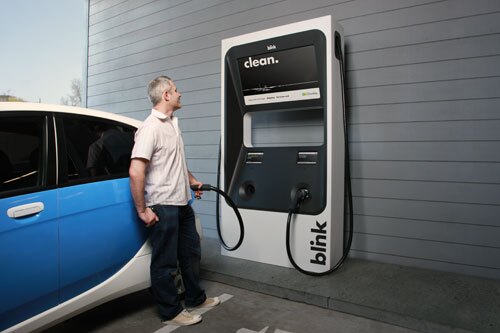New Electric Car Fast-Charge Site in Downtown L.A.

Blink fast charger | Photo: Blink Network
As of yesterday, charging your electric car in one Downtown L.A. parking lot has gone from being a time-consuming ordeal to a mere inconvenience. A new Blink DC fast charger installed yesterday in a Mateo Street parking lot in Downtown's Arts District will charge a typical electric car in about half an hour, as compared with 6-8 hours for a typical "Level 2" 240-volt charging station.
The fast charger recharges vehicles such as the Nissan Leaf with 500 volts of direct current, topping off a car battery pack much more quickly than the 220-volt Level 2 stations electric car owners install in their homes.
The new charger, which joins a row of ten Level 2 chargers already installed in the parking lot, is the first fast charger in Los Angeles.
Siting of electric vehicle chargers is tricky, and must take into account typical electric vehicle range -- 35 miles for a Chevy Volt, and about twice that for a Nissan Leaf -- and traffic patterns in the neighborhood. As the city of Boulder, Colorado has found, standard chargers in locations within round-trip range of people's homes tend not to be used; the inconvenience of long charges is just too much and people might as well just recharge at home.
Fast chargers do address some of this problem, though at a trade-off: with current technology, faster charging can reduce battery pack lifespans. And half an hour for a full charge is still longer than many parking lot visits.
One of the firms involved in yesterday's charger unveiling, Wheelz, is in the car-sharing business, which may pose a partial solution to the charge time issue as well: if well coordinated, a small fleet of electric cars shared by a group of people for short daily trips may be more amenable to central fast charging than cars used by one owner.
As storage technology improves and fast charge stations become more common, the overall futziness of making sure your car is charged for other than commuting purposes will decrease. In the meantime, the manufacturer of L.A.'s new charging station can help you make a reservation to top off your battery so that you won't get there and find three people in line ahead of you. That's something, anyway.
ReWire is dedicated to covering renewable energy in California. Keep in touch by liking us on Facebook, and help shape our editorial direction by taking this quick survey here.


